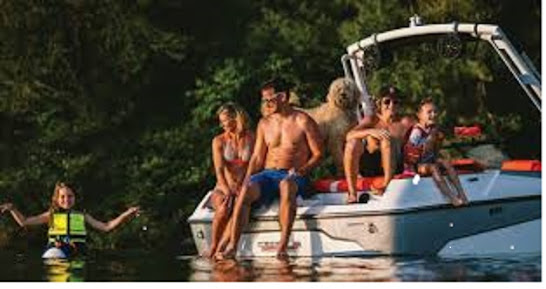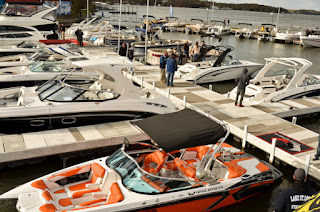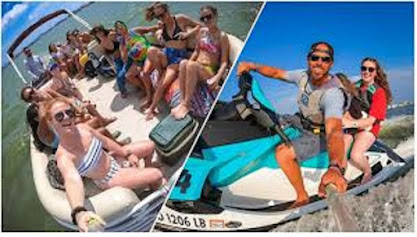Memorial Day On The Water
Memorial Day has come and gone, and happy to report
for the week end holiday, here in Missouri, the Missouri State Highway Patrol
Water Division reported No Boating
Fatalities, & No Drownings Over Memorial Day Weekend.
Boating Statistics
Crashes -- 6
Injuries -- 3
Fatalities -- 0
Drowning -- 0
BWI -- 7
Drug Arrests – 0
However, always a
but. It was really evident that there
were many first-time boaters, boaters that were not educated in the basic
navigation rules. Boaters that didn’t care or had the attitude for I am on
vacation and what I do stays here and do not take responsibility for my
actions.
With that in mind, let’s review some simple boating navigation rules and boating courtesy.
1.
There
are two types of vessels on the water ways.
They are: Stand-on and Give-way.
So
simply put, the Stand-on vessel is the boat that continues at the same speed
and direction. The Give-way vessel is
the vessel the yields.
2.
When do
you Stand-on or Give-way? Again, just
like driving a car. You will encounter
three basic scenarios.
a.
Head on. If another boat is approaching, you head on,
both boats are Give-way. both boats will
turn to their right. Each vessel will
pass each other port to port.
b.
Crossing. Just like when you are driving a car and come to a four-way intersection
that is uncontrolled. The Boat to your
right is the Stand-on vessel. Your boat is the Give-way or yield to the boat to
the right. Be sure to pass the stand-on
boat to its stern, never attempt to cross in front of the stand-on vessel.
c.
Over-Taking. In the instance you are approaching a boat that may be slower than
you. The boat you are overtaking is the
Stand-on vessel, you boat is the Give-way, so if traffic allows you pass the
vessel you are over taking and pass to the left, in some cases you will pass to
the right. Note, when passing pass with
enough distance where your wake will not cause damage or swamping, rocking the
other vessel. A distance of 100 ft is
recommended, between both vessels.
When in doubt if you are a Stand-on or Give-way? be the Give-way, remember you job as the captain is to avoid boating incidences and accidents.
3.
Towing a
skier and tubing or wakeboarding. What
is needed, when to use the skier down flag.
a.
When
towing a skier or pulling a tube. You
must have an observer. In Missouri, rear view mirrors are not permitted. The reason for the observer their job is to
be a look out to notify the captain when the skier falls off the skis or when
the people on the tube gets tossed off.
When a person is in the water, that is when you raise the orange /red
flag. The sole purpose of the skier down
flag is to make other boaters, that is a person in the water, and you are
attempting to pick them up or allow them to get back on the skis or tube.
When that person is back up and skiing or tubing the flag comes back
down. DO NOT ride around with the flag
up all the time. The Missouri water
patrol will most likely stop you and issue a warning.
b. When skiing or tubing do not do this activity in the main channel. It is difficult to see when someone is in the water and could be injured by a prop. Find a large enough cove to perform this activity. Please, when Skiing, Tubing or Wakeboarding. 1, Stay at least 100 feet away from docks. 2. Be considerate of other vessels that may be anchored, or fishing stay away at lease 100 feet. If necessary, reduce your speed. 3. Understand all posted Buoys. Remember to share the waterway. Be sure all involved wear a lifejacket.
4.
Over the Holiday, one unfortunate
boater ran aground on an underwater reef, at Lake of the Ozarks. The area was plainly marked off with
exclusion and danger buoys. Lucky, no
one was hurt and all on board escaped.
The boat, however, was a total loss.
What is a buoy: A buoy is a floating object that is used to show ships and
boats where they can go and to warn them of danger, provide
information, or regulate traffic.
There are four main types of buoys used in inland waters. They are:
Information Buoy: These
are marked with a square, they give information other than the edges
of safe water areas. They are found on lakes and rivers and give directions and
information, mark controlled or closed areas, indicate where food and gas
possible hazards.
Here at Lake of the Ozarks information buoys are
mounted on dock floats and a large billboard with written instruction.
Danger Buoy: Diamonds warn of hazards such as rocks, shoals, or turbulent
waters. Always proceed with caution and keep a safe distance. Never assume that
every hazard will be marked by a buoy.
Control
Buoys: Circles
indicate a restricted boating area such as no wake, idle speed, speed limit, or
wash restrictions. You must obey the restriction inside the circle.
Keep-Out Buoys: or
also called exclusion area buoys these are marked with crossed diamonds
indicate areas where pleasure craft are prohibited such as dams and spillways,
swim areas or endangered aquatic habitat.
When boating is a good idea to keep a
distance of 50ft away from a buoy. The
reason is all buoys and anchored to a weight (sometimes call a dead man) by
means of a cable or chain. At low water
tables, the cable of chain could become entangled in the lower unit of the
motor, and cause damage.
5. Gas Dock Courtesy With the number
of boaters, it was noticed that there were lines of boats waiting for
fuel. Most people were patient and
courteous. However, many were not.
At any given time at Lake
of the Ozarks on a weekend or holiday there can be over 160,000 boats on the
water. Before going out on the water, it
is important to fuel up the day before if possible. Remember, most of the gas docks are limited
to the number of gas pumps as well as personnel to service you.
A few helpful hints.
a. Know
your fuel tank capacity. When fueling
only fill to 90% do not keep filling so that the fuel exits through the
over-flow vent. This contaminates the water
and causing a fire hazard.
b. If you are approaching the fuel dock and there is a line wait your turn, be courteous. Don’t barge in front of a boater waiting to dock or may have problems is docking.
c. After
fueling is complete if you have a inboard or a inboard/outboard run the blower
for at least 4 to 5 minutes. Go in to
the sea store pay for your fuel and other items. Then start your engines and leave the dock
allowing another boat to gas up. Don’t
not linger, inform your passenger to purchase or use the restroom quickly.
Remember, there other boaters,
d. Lastly
tip the dock people. They are doing their best.
Remember, everyone is on the water to enjoy and make great
memories. Do your part in sharing the water-ways, be courteous, and safe.




Comments
Post a Comment